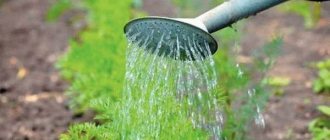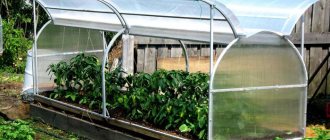5/5 — (4 votes)
There is no such gardener and gardener who would not plant beets. One of the most common vegetable crops, it is easy to grow and has a long shelf life. Indispensable in borscht, vinaigrettes and beetroot soups. Its history dates back to the times of Kievan Rus.
Today we will talk about how to plant and grow beets in open ground, as well as when and how to sow in order to get a good harvest. Consider planting seeds in open ground and seedlings. I will say right away that growing beets is a completely simple task that anyone, even a novice gardener, can cope with.
In the meantime, while you haven’t planted it yet, I recommend growing and harvesting radishes and treating yourself to a wonderful okroshka.
Choosing a beet variety
When choosing beets for planting, they are assessed according to several criteria - ripening time, taste, color and shape.
Beet varieties according to different criteria:
- According to the ripening period. Varieties are divided into three categories:
- Early beets. From the emergence of seedlings to harvesting, it takes from 80 to 110 days. Popular early varieties: Carillon, Bolivar, Egyptian, Red Ball, Nastenka, Vinaigrette.
- Average. The growing season is 110-130 days. Popular mid-season varieties: Sonata, Crimson Ball, Delicatessen, Globus F1.
- Late. Root crops ripen in 130-145 days. The best late varieties: Matrona, Citadel, Frona, Cylinder.
- Keeping quality. Not all beet varieties store well. Most often, late varieties are stored for storage. But among early and middle beets there are also long-lived root crops. The following varieties are recommended for storage: Nosovskaya flat, Crosby, Rocket F1, Madame Rouzette F1, Tenderness, Tsyganochka.
- Taste. The sweet taste of beets depends on its sugar content. Root vegetables that are high in sugar not only taste good, but are also easy to process. They make delicious juices and are included in children's menus. The sweetest beet varieties: Bravo, Ordinary Miracle, Kozak, Vysokaya, Mulatka.
Experts have compiled a rating of table beets, in which they have collected the best varieties:
- Andromeda F1. Early maturing single-germ hybrid. The root vegetable has a cylindrical shape, grows up to 6.5 cm in diameter. Weight – 600-700 g. Juicy, quickly boiled pulp retains its color after heat treatment. Minus - it is affected by cercospora blight, rot, powdery mildew and root beetle.
- Kedry. Mid-season variety with shelf-stable root crops. Shape – cylindrical, weight – 300-320 g. Has high immunity. From 1 sq. m are collected at 7 kg. The root crop protrudes 2/3 out of the ground.
- Rival. Mid-season, high-yielding variety with excellent taste. The root vegetables are medium-sized, dark red in color. Diameter – 4-6 cm. Weight – 200-300 g. The pulp is tender and juicy. The variety is demanding when it comes to watering. From 1 sq. m, 5-7 kg of beets are collected.
- Black woman. Mid-season variety with spherical roots. The sugar content is average, but this does not affect the taste. From 1 sq. m harvest 5-8 kg of beets.
- Opolsk. Mid-season variety of Polish selection. The shape of the root crops is elongated, weight – 180-440 g. The root crops are half immersed in the ground. The variety is susceptible to Phoma and Cercospora blight. Productivity – 3-5 kg per 1 sq. m.
Choosing a site for beets depending on location
Like other vegetables whose roots are eaten, beets love loose, water-permeable fertile soils with a large supply of nutrients. Soils that tend to accumulate moisture without allowing it to pass through are completely unsuitable for it. Clay soils have a structure that is too dense, which does not allow sufficient air or water to pass through to plant roots. Sandy soils absorb water well, but do not retain it at all.
For sowing beets, choose flat areas in a place well lit by the sun. Low-lying areas are not used for several reasons: · Water may stagnate there and young plants will dry out. · In such areas, the soil often has an acidic reaction, and beets, like all root vegetables, do not like it. On acidified soils, plants are affected by various diseases, degenerate and die.
In the lowlands, slugs and snails like to hide from the summer heat; they are not at all averse to feasting on tender young beet leaves. In some cases, plants die only because the “tops” are completely eaten.
Elevated areas should also be avoided, as the soil dries out faster there and the beets get very little water. The ideal area for sowing or planting seedlings of this plant is level, carefully cultivated in the fall, well and generously filled with humus and rotted plant debris (compost). Water delivery must be well established on the territory, since plantings need to be watered quite often and abundantly, especially in the early stages of seedling development.
Since beets do not tolerate high soil acidity, to increase yield and reduce the risk of diseases, lime or dolomite flour is added to the soil in the fall (at the rate of approximately 1 cup of powder per square meter of area).
Having chosen a suitable site, all that remains is to figure out how to make beds in the garden for beets and what tools will be needed for this. It is very important to make sure that the soil for root crops does not contain solid inclusions (stones, root debris, etc.). If such objects are found in the ground, you need to try to remove them. Otherwise, root crops, encountering a stone or other solid inclusion in the soil, may grow crooked and ugly. The easiest way to remove stones is during autumn digging or plowing.
The area selected and prepared before winter is not dug up, but only loosened and leveled.
The rows are usually laid out in the direction of the sun so that the plants constantly receive the maximum amount of its life-giving rays. For marking, it is very convenient to use pegs made of wood, metal or plastic with rope or propylene twine. Clearly marked rows and plants sown along them make it easier to weed the area, especially while the seeds have not yet sprouted or the plants are still very small and unnoticeable. Weeding is mandatory, since weeds take away water and nutrients from the soil from still weak cultivated plants.
For sowing, shallow furrows are made, approximately 2 - 3 cm. 25 - 30 cm are left between rows. For ease of subsequent maintenance, several rows can be connected together, leaving wider row spacing on both sides. You can combine from 2 to 4 rows, then from both rows they can be weeded and loosened, reaching with a tool without unnecessary effort and without bending too low to the bed.
Having figured out how to make beds for beets, you need to figure out how to sow the seeds and care for the sown area.
Preparing for landing
The success of growing beets largely depends on the quality of the soil and the timing of planting. We will learn how to prepare soil and seeds for planting, and how to choose the right site.
Optimal timing
Beetroot is a relatively heat-loving crop, which should not be planted in a hurry. When determining sowing dates, the climatic features of the region are taken into account.
Temperatures recommended for sowing beets:
- Air – from +15 to +18 °C.
- Soils – from +6 to +10 °C.
Approximate sowing dates for different regions:
- Southern regions - in the second half of March or April.
- Middle zone (Moscow region) – mid-May.
- Ural and Siberia – second half of May.
The timing of planting is also influenced by the variety - early varieties are sown earlier, late-ripening varieties are sown later than others.
If late beets are sown too early, their roots will grow tough and tasteless.
Beets can be sown before winter. Do this before frost sets in. For winter sowing, only special varieties are used. The crops are covered for the winter. Winter beets germinate early, providing an early harvest.
Crop rotation
When choosing a site for planting beets, you need to take into account what crop grew on it previously. Table beets have favorable and unfavorable predecessors.
Beets grow well after:
- potatoes;
- Luke;
- pumpkins;
- peas;
- cucumbers;
- beans;
- garlic
It is not recommended to plant beets after:
- cabbage;
- carrots;
- celery;
- beets.
Neutral predecessors:
- zucchini;
- pepper;
- radish;
- greenery;
- radish;
- tomatoes.
It is not recommended to plant beets in one place. At least 3-4 years must pass between crop sowings.
Site selection and soil preparation
In order for red beets to grow large and tasty, they need to create favorable growing conditions. And this process begins with choosing a site.
When choosing a site, take into account the following requirements:
- Good lighting is necessary.
- Soils must be nutritious and loose. Peat soils, sandy loams, and loams are suitable for beets.
- Beets require space to grow, so there must be enough space between adjacent plants for the root to grow.
- The crop can be planted as a “border” along potato or cucumber plantations, near beds with onions or herbs.
- Beets require frequent watering. To prevent water stagnation, the crop must be planted in well-drained areas.
It is recommended to prepare the soil for planting beets in the fall:
- Remove plant debris and dig up the soil, adding organic matter - manure or compost. Fertilizers should be buried 30-35 cm.
- If the soil is highly acidic, sprinkle slaked lime over it - 0.5-1 kg per 1 square meter. m. You can also use crushed egg shells, dolomite flour or wood ash.
- Apply mineral fertilizers - potassium sulfate or superphosphate - in the fall. Spread the granules over the soil and dig up the beds. For 1 sq. m – 300 g of fertilizers.
- In the spring, dig up the bed again and sprinkle peat or rotted sawdust on top.
Fertilizer dosage when preparing soil for beets:
| Fertilizer | Quantity, g per 1 sq. m |
| Ammonium sulfate | 20-30 |
| Ammonium nitrate | 15-20 |
| Potassium chloride | 10-15 |
| Superphosphate | 30-40 |
If you exceed the dose of fertilizers, the root crops will be of poor quality - with loose pulp, cracked, with voids.
It is recommended to make beds for planting right before sowing the seeds, then there will be more moisture in the soil and seedlings will appear faster.
Preparing seeds for planting
Beetroot has large seeds that are easy to plant, observing the required intervals. If purchased seeds are pink or green, it means they have already been treated with fungicides and stimulants and are completely ready for planting.
Treated purchased seeds cannot be soaked or germinated; they must be planted in the ground dry.
Unprocessed seeds are brown or sandy in color. Such planting material must be prepared for planting.
How to prepare seeds:
- Germination test. Soak the seeds in salt water. After a few hours, check the result - discard all the floating seeds, they are not germinating or will produce small root crops.
- Disinfection. Soak the seeds for 12 hours in a slightly pink solution of potassium permanganate.
- Hardening. Alternately soak the seeds in hot and cold water for several hours.
- Processing in a stimulator. Wrap the seeds that have passed the germination test in gauze and immerse them in a solution of Zircon, Epin or another stimulant. The exposure time is from 30 minutes to 4 hours, depending on the type of drug.
- Drying. Remove the seeds from the stimulator, rinse thoroughly and place them in a warm place for 24 hours. During this time, the seeds will swell, and some will even begin to hatch - now they are ready for sowing.
If seeds are planted before winter, then preparation comes down to testing for germination and disinfection. Excessively swollen seeds can germinate, which will lead to their death.
Seed preparation
Beet seeds are called glomeruli. They contain 4-5 seeds, and upon germination they form thickened shoots. Therefore, before preparing, you can rub the balls in your hands (carefully) and divide them into smaller parts.
About 10-12 days before planting, you can prepare the seeds for sowing. In water heated to 35-40°C, soak the seeds in a gauze bag for up to 8-10 hours. Place the swollen seeds in a pink solution of potassium permanganate for another 3 hours. Then dry on a cloth or paper towel.
Disembarkation instructions
Beet seeds are relatively large, so there are no difficulties when sowing them. Unlike carrots, radishes and many other crops, there is no need to mix beet seeds with sand - they can be evenly distributed over the planting area without this.
Sowing seeds
If the soil has warmed up, you can start sowing. There is no need to rush, the soil should warm up to a depth of 8-10 cm. Seeds planted in cool and damp soil may rot before they have time to sprout.
The procedure for sowing beets in open ground:
- Make furrows 2 cm deep in the beds. Use a board to keep them level and with a dense bottom. Press the end down into the loosened soil. The distance between the furrows depends on the size of the root crops:
- for small beets – 10-15 cm;
- for large beets to be stored – 20-30 cm.
- Water the furrows with a watering can. Water carefully so as not to wash away the soil.
- When the water is absorbed, spread the seeds along the grooves. The distance between seeds is from 4 to 10 cm. The interval is selected taking into account the variety and purpose of the root crops.
- Fill the grooves with soil or rotted humus.
- Water the plantings through a rain nozzle.
Planting seedlings
To obtain early beet harvests, the seedling growing method is used. The first root crops are obtained already in July. Seeds are sown for seedlings in March-April, and planted in the ground in April-May, depending on the region.
Beet seedlings are transplanted into open ground when they have 2-3 true leaves.
When growing beet seedlings, overgrowth should not be allowed. If the roots of the seedlings rest against the bottom of the seedling container, the root crops may grow deformed.
The order of planting seedlings:
- Make holes in the prepared beds. Their size should be such that the roots of the seedlings fit comfortably into them. The intervals between holes depend on the variety:
- cylindrical beets – 10-12 cm;
- medium-sized beets – 12-15 cm;
- beets with large rounded roots – 15-20 cm.
- Water the holes and wait for the water to be absorbed.
- Plant the seedlings in the holes, placing the roots evenly, without bends.
- Water the seedlings again.
- Cover the plantings with covering material for 2-3 days until the seedlings take root.
If the weather is hot, water the plantings every day. When the plants take root, the frequency of watering is reduced to once a week.
When growing beets using the seedling method, there is no need to thin out the plantings.
How to properly plant beets for seedlings at home
As I already wrote, to obtain early fruiting, beets are often planted through seedlings. There are a lot of ways to sow seedlings. We use probably the simplest and most reliable one, we plant it in cassettes with soil. I'll explain why.
A beet seed is not one seed, but a ball of infructescence from which several sprouts grow, sometimes up to five. When they all grow, there is a need for mandatory thinning. Of course, there are already single-sprout seeds, for example Single-sprout, Egyptian flat, Chervona kula, Bordeaux improved, Pablo F1, Boro F1, Larka and many others. But they often sell multi-sprouted seeds, which must be thinned out.
Beets, as I already wrote, place high demands on the availability of nutrients in the soil. By planting seeds in a cassette, you can easily fulfill these two requirements. Sitting on a chair at home, it is convenient to thin out seedlings, and the nutritious soil will provide the seedlings with everything they need. And the subsequent transplantation of seedlings into a garden bed along with a lump of earth is not something painful for the seedling. Often, on the contrary, on the second day after transplantation you can see how the seedling sharply began to grow.
Prepare the soil for planting. To do this, you can take any store bought soil or soil from your garden and add vermicompost in a 3:1 ratio, i.e. to three parts of land, one part of vermicompost. Mix everything and fill the cassettes with the prepared substrate. Compact a little. It is convenient to do this with a plastic cup if you fill it with something.
Cassettes are convenient to use with a diameter of 3.5 cm and a depth of 5 cm. If the size is smaller, there will be little room for the roots.
Place one seed at a time and cover with soil.
Be sure to pour well. Cover with a bag or glass. This way you will make a small greenhouse. This completes the landing. Place the cassette in a dark place at room temperature +20...+23 degrees.
Shoots will appear on days 3-7.
Remove the film or glass. At this time, it is advisable to move the cassette to a sunnier but cooler place with a temperature of +15...+18 degrees. When the sprouts grow by 2-3 centimeters, you can thin out the seedlings. To do this, leave one, the largest sprout, and simply pull out the rest. You can throw them away or plant them in another glass in which the seeds did not sprout; they take root very well.
Further care of the seedlings consists only of watering. Do not allow the soil to dry out. Sometimes a whitish-cream colored mold forms on the surface of the soil. In this case, remove it mechanically and sprinkle the surface with ash mixed with river sand.
The seedlings are ready for planting in open ground when two true leaves reach a size of 4-5 cm. In this case, the roots usually fill the entire volume of the cup. When planting for permanent residence in a garden bed, the entire contents of the cup are planted along with a lump of earth.
Features of winter and spring sowing
Beets are crops planted both in spring and before winter. If the seeds overwinter safely, you will be able to get early beets without growing seedlings.
Winter sowing
In late autumn, when winter crops are sown, beets begin to be sown. The winter beet harvest ripens 2-3 weeks earlier than its counterparts sown in the spring.
Features of winter sowing:
- The optimal sowing time is the last days of October or the beginning of November, when the soil has already cooled.
- Even if the snow has already fallen, you can sow. The main condition is cool soil so that the seeds do not sprout. They should only swell in the soil, nothing more.
- For winter sowing, choose seeds that are resistant to cold.
- In autumn, the number of seeds planted should be 20% more than in spring.
- The varieties most suitable for pre-winter sowing are those that are resistant to flowering and bolting.
- In order for the seedlings to emerge as early as possible in the spring, the seeds are planted on the ridges. On the formed ridges, grooves 5-6 cm deep are made.
- Seeds placed in furrows are sprinkled with a mixture of substrate and humus. The crops are insulated with compost.
Spring sowing
Spring sowing is most common among gardeners. This is the simplest and most win-win option for growing table beets, practically devoid of risks and surprises.
Features of spring sowing:
- You can plant the seeds dry, without soaking. Especially if it rained shortly before sowing and the soil was wet.
- The looser and lighter the soil, the deeper the seeds are planted. The planting depth during spring sowing varies from 2 to 4 cm.
You can learn about the intricacies of planting beets in the following video:
Rules for sowing table beets
The process of sowing table beets begins in early May, when the soil has warmed up well. Sowing is carried out on a flat surface at a rate of 1.5-2 grams to a depth of 2-3 cm from the surface. Alternatively, the seeds are first germinated and then planted. It is possible to plant ready-made seedlings when they have 3-4 leaves.
When planting table beets in the fall, you can get a ready-made, mature product as early as the end of June. In this case, sowing is carried out in late October-early December in furrows or beds at the rate of 2-3 grams per 1 m2. The seeding depth is 3-4 cm. Such crops should be fertilized with peat or humus.
Caring for beets in open ground
Beets are an unpretentious and drought-resistant crop that does not require much care from the gardener. But in order to get a good and high-quality harvest, it is important to provide the beets with proper care.
Temperature and light conditions
Beetroot is a light-loving crop. It needs good lighting throughout the growing season.
Features of the light mode:
- The optimal length of daylight hours is 13-16 hours a day.
- When daylight hours are reduced to 10-11 hours, beets stop the growth of root crops, only the above-ground part grows.
How temperature affects beets:
- Beets are capable of sprouting in soil whose temperature is only +3…+5 °C. True, germination is delayed, the first shoots appear only on the 23rd-24th day.
- The higher the temperature, the sooner the beets will rise. At a temperature of +20...+25 °C the vegetable germinates in a week.
- If the temperature rises above +25 °C during beet germination, the seedlings may die.
- When plants have 3 or more leaves, they will be able to more resistantly withstand unfavorable temperatures.
- If the temperature drops a few degrees from the minimum permissible, the growth of root crops stops, and the quality and quantity of the harvest decreases.
Subtleties of watering
Beets can withstand drought, but this quality should not be abused, since moisture deficiency can negatively affect yields.
Features of watering beets:
- If the weather is hot and dry, the plantings are watered by sprinkling.
- It is better to use warm and settled water for irrigation.
- The frequency of watering immediately after emergence is once every 2-3 days.
- To retain moisture in the soil and reduce the frequency of watering, the soil is mulched, for example, with dried grass.
Watering alternates with loosening the soil. It is necessary to loosen the beets very carefully so as not to damage the growing root crops. Beetroot does not need hilling.
Thinning
From one beet seed, 2-4 sprouts can appear at once, so the plantings have to be thinned out. If this is not done, the root crops will not be able to develop normally and will not grow to their varietal size.
During the planting season, beets are thinned twice:
- When the seedlings have formed 2-4 true leaves. By this time, the plants reach a height of 7-8 cm. First, the weakest shoots are removed, and at the same time weeds are pulled out.
- When plants are at the stage of root formation. A distance of 8-10 cm is left between neighboring plants. Varieties with large root crops are thinned out more, leaving gaps of 15-20 cm.
Feeding
Beetroot needs enough fertilizer applied before planting. It is necessary to apply fertilizing only when there is a noticeable lag in plant growth.
Beet roots actively accumulate nitrates, so it is recommended to feed the crop with natural fertilizers.
How to feed beets:
- Periodically water with herbal infusions diluted in water or yeast solutions.
- 2-3 times during the planting season you can water it with a slightly saturated saline solution - dissolve 1 tbsp in 10 liters of water. l. salt.
- Apply any complex fertilizer, following the dosage specified in the instructions.
- If ash has not been added since the fall, it can be used in the summer. Every two weeks, add ash to the water for irrigation - one glass per 10 liters.
- Ready-made mineral fertilizers can be applied to insufficiently fertile soils:
- Potassium. Contributed twice a month. Any potash fertilizer is suitable except for manganese - it makes the soil acidic.
- Nitrogen. Add only when necessary. Fertilizer is poured into furrows dug at a distance of at least 5 cm from the roots.
- Bor. Apply twice a season. 2 g of boron are diluted in 10 liters of water.
Further care
If the preparatory work was carried out correctly, further care of the seedlings is not particularly difficult. There are just a few important points to pay attention to.
Watering
There is no need to water beet beds too often - this is even harmful to the crop, since the abundance of moisture, although it promotes the formation of large root crops, at the same time significantly reduces the sugar content in them. Although beets do not like overwatering, the culture reacts with great gratitude to an evening shower that refreshes the leaf rosettes, so this crop, unlike, for example, tomatoes or eggplants, should be watered not at the root, but at the leaves.
Did you know? Each kilogram of quality root vegetables is accompanied by the extraction from the soil of at least 0.35 g of phosphorus, 0.7 g of nitrogen and 0.1 g of potassium.
The maximum yield of root crops is usually obtained with the following combination of moisture and heat:
- May - warm and humid;
- June - not hot and humid;
- July - not hot and humid;
- August - hot, but not dry;
- September - warm and dry;
- October is warm and dry.
Thus, the beds should be watered moderately, without allowing them to dry out too much.
Thinning of plantings
Thinning beet seedlings, like other root crops, must be carried out, otherwise the plants emerging from the same seed will suppress each other. The procedure is carried out approximately 7 days after the emergence of shoots, and this should not be delayed. The weakest plant should be removed, trying to act as carefully as possible so as not to damage the root remaining in the ground. If the “operation” was successful, and the sprout was removed along with the roots, such a seedling can be planted in a free place, and it will most likely take root.
Important! It is not recommended to use coniferous branches for mulching beds with beets, since such material greatly increases the acidity of the soil.
Fertilizer application
Beetroot is one of the crops that needs regular feeding. The procedures begin to be carried out within 2-3 weeks after the appearance of the first shoots and are then repeated at intervals of up to two times a month (however, each gardener determines the schedule independently, focusing on the initial composition of the soil and the appearance of the plants).
If the bulk of nitrogen fertilizers are best applied to the soil before sowing, then the phosphorus and potassium necessary for the plant are applied throughout the season. As for organic matter, it is also usually added before planting, sometimes even long ago.
Tillage
Weeds are a serious problem for beets. In the vicinity of weeds, this crop becomes very elongated, the root crop becomes small, gets sick and lags behind in development. Therefore, regular weeding is a prerequisite for obtaining a good harvest.
To prevent the soil in the bed from cracking and to better retain moisture, after rain and each watering, when the water is completely absorbed into the ground, the bed needs to be loosened. Since the root system of beets goes deep and is not located near the surface, the soil can be loosened thoroughly, going a few centimeters deep.
Find out more about how and when to plant beets before winter.
You can save yourself from the need for loosening by mulching. The same procedure partly helps to get rid of weeds. Initially, it is best to use young mown grass as mulch, and it should be laid in a thin layer (no more than 1–2 cm). After the plants get stronger, the mulch layer is usually increased. At this stage, you can use coarser material - such as straw, or even weeds removed from the bed.
So, growing beets in open ground requires serious theoretical preparation. It is ignorance of the basic requirements this crop imposes on environmental conditions that prevents summer residents from getting a good harvest. However, if these simple rules are followed, the result will not be long in coming.
Harvest and storage
Beets ripen in 50-70 days. But during the growing season, root vegetables can be used for food throughout the season.
Features of cleaning and storage:
- Beets must be harvested before frost sets in. If root vegetables are frozen, they will quickly spoil during storage.
- Unripe beets do not store well, while overripe ones taste rough and are prone to cracking.
- Beets are harvested in dry weather, when the soil is easily shaken off the root crops.
- It is recommended not to cut the tops, but to unscrew them, so as not to damage the root crops.
- Root crops that are sick and have signs of damage, as well as those that are too small or too large, should not be stored.
- Beets removed from the soil are immediately stored.
- The optimal temperature in the basement is +2…+3 °C.
- If root crops are pollinated with chalk - 250 g per 10 kg, or sprayed with infusion of pine needles - 50 g of pine needles are infused in 1 liter of water for 4 days, then they will be stored better.
Choosing a place to grow beets
The most suitable soil for beets is loam rich in humus, but it can grow on others. True, on heavy clay soils, if the beets are not watered enough, the root crops usually become more bitter, but this does not mean that beets cannot be grown in such areas, you just have to be more careful that the soil does not dry out.
In general, beets do not have any special or even more stringent requirements for soils, as long as they are sufficiently nutritious and not too acidic (slightly acidic soils are quite suitable). Soil preparation affects the yield of beets a little more strongly: you need to dig them deeply in the fall (at this time it is better to treat them twice: first disk them, and plow them in two or three weeks), and in the spring they should be well loosened and leveled. In some places - on heavy and floodplain soils - in the spring it is worth digging it up again, although not to its full depth, and wherever the groundwater level is high, it is necessary to make high ridges for beets, because they do not tolerate dampness, they will rather put up with it with drought.
It is necessary to fill the soil for beets with mineral fertilizers (you can do it in the spring): per 1 m2 it requires 15-20 g of ammonium nitrate, 30-40 g of superphosphate and 10-15 g of potassium chloride. On very poor soils, you can also add organic fertilizers, but in the fall - without fresh manure: after this, beets can be sown no earlier than 2-3 years later, otherwise the root crops will turn out ugly and tasteless. Don’t forget about this if you have beets growing next to other vegetables, in the same bed with them: even if the main crops need manure, here it is better to replace it with something else, and if it has already been applied, look for another one for the beets garden bed
Beets do not like shade, so you need to give them a brighter place.
As for crop rotation, you can safely plant beets after almost all vegetables, except turnips and rutabaga (they are also chenopods), but it works especially well after potatoes, cucumbers and peas.
Beet diseases and pests
Beets have high vitality and immunity. Most of its diseases are associated with poor agricultural practices and lack of nutrients.
Diseases of table beet and measures to combat them:
| Diseases | Symptoms | How to fight? |
| Fomoz | Yellow-brown spots with a concentric pattern appear on the leaves. Root crops infected with Phoma rot during storage. | Treat the seeds with Fundazol. |
| Cercospora | Red spots appear on the leaves, and a gray coating appears on the reverse side. | Feed with ash or potassium chloride. The seeds are treated, sprayed with copper-containing preparations every 10 days and treated with fungicides. |
| Fusarium | The leaves turn yellow and wither. The fungus also attacks root crops. | Spray with boric acid. Liming of acidic soils is carried out. |
| Corneater (black leg) | Affects seedlings. The stems become thin, turn black, and the plant dies. | There is no treatment. Prevention – improving soil aeration. |
The main pests of beets:
- Medvedka. Lives underground, digs tunnels and damages root crops. It is recommended to treat burrows and paths with a solution of boric acid. Scatter granular poison, for example, “Thunder”.
- Nematodes. The larvae eat the root system of beets. The leaves of affected plants wilt. Plants affected by nematodes are pulled out and destroyed.
- Beet fly. The leaves of the affected plants turn yellow and wither, which are eaten by the fly larvae. Control measures include deep pre-winter digging, weeding, spraying heavily affected plantings with any contact insecticide.
Flea beetles, slugs and wireworms also damage beet plantings. They are combated mainly with preventive measures and natural remedies - tobacco dust, ground pepper or wood ash are scattered on the soil.
How to grow good beets: planting, watering, fertilizing beets
Beets cannot be considered a capricious plant, and yet some gardeners often fail. A lot has been said about growing beets, but today we invite you to consider the most common mistakes and questions that arise when growing beets - about planting beets, proper watering and fertilizing of beets, thinning and soil for beets.
Soil for beets: sour - yes, heavy - not
Soil acidity for beets varies between 6.2...7 pH - neutral or slightly acidic. What happens to beets planted in too acidic soil? Micro- and macroelements are poorly absorbed, and gas-retaining soil bacteria die, which is why beets begin to suffer from nitrogen deficiency.
Therefore, the acidity of the soil for beets must be controlled - either with litmus paper (sold in garden stores) or with improvised means. If the acidity is too high, be sure to deoxidize the soil with lime, chalk, ash, and dolomite flour.
Otherwise, don’t be surprised why beets grow poorly: the acidic environment interferes with the absorption of minerals.
The second important indicator is how light the soil is. In dense soils, it is difficult for root vegetables to develop: carrots grow clumsy, beets grow small. Therefore, either sand is added to it, but better - compost or rotted sawdust. Thanks to this, the soil becomes air and moisture permeable.
Owners of dense soils can go another way: plant beet varieties that protrude greatly above the surface of the earth. Beets are not potatoes, the sun does not harm them. On the contrary, varieties with only the tail hidden in the ground are usually sweeter. As a rule, manufacturers note this varietal feature on seed packaging.
The ideal soil for beets is loam, fertilized with organic matter and humus. In addition, the soil in the beet bed is regularly loosened so that a crust does not form on the ground, which impedes gas exchange. And to make your work easier, you can cover the soil with mulch - grass, sawdust, pine needles and any other available materials.
When to plant beets? Better - later
Although beets and carrots are considered the main root vegetables in the garden, they cannot be called sisters. Carrots are more cold-resistant: they can be planted before winter, and in the spring before planting potatoes.
Beets, with the exception of specialized winter varieties, are not planted in the fall, and not in early spring either. You need to wait until the soil warms up to 8-10 degrees (immediately after planting potatoes, or when the leaves on the birch tree are as big as marigolds).
That is, not earlier than the beginning of May, but for the northern regions and the beginning of June.
What happens if beets are planted very early ? Firstly, it can easily go into bloom without setting a root crop. Secondly, when exposed to frost, and even just low temperatures (+4 degrees and below), beets are threatened by root beetles.
This is not a pest, as the name might suggest, but a disease comparable to “black leg” in seedlings. Seedlings weakened by cold are immediately attacked by the fungus. As a result, the sprout darkens, rots and dies.
Even if a root crop that has suffered from a root beetle manages to survive, it lags behind in development and will not please you with the harvest. Therefore, there is no need to rush to plant beets in open ground.
But residents of the northern regions can start planting beet seeds for seedlings in early May. Compared to carrots, beets tolerate transplantation well.
Seeds are sown either in a greenhouse, covered with lutrasil, or in boxes, wrapped with the same lutrasil in several layers.
The box is placed on a stool (it’s warmer) and placed either on the veranda, balcony, or in the open air (for example, under the southern wall of the house).
How thick should I plant beets? If through seedlings, then according to the 15x15 cm pattern. And if you like small beet heads (for one borscht), then it is better to reduce the feeding area and plant according to the 10x10 cm pattern, or plant two plants in one hole at once.
If you are sowing beets in open ground, then it is better to initially sow thicker than necessary to be on the safe side: then remove the excess seedlings, but you will not be left with a “bald” bed. But they remove excess sprouts not in one go, but in two or three.
As soon as the cotyledons unfold, carry out the first thinning, leaving 1-2 cm between plants. Do this on damp soil so that the seedlings are easier to remove from the ground. And if your garden bed is small, you can cut off excess seedlings with scissors so as not to accidentally pull out strong neighbors.
Since beets tolerate replanting well, thickening plants can be transplanted to another bed in the phase of 2-3 true leaves. The second or third thinning is carried out when the plants reach a maximum of 8-10 cm.
Leave 10-15 cm between beets - if the soil is good, fertile, and 20-25 cm - if the soil is heavy, poor.
Fertilizing and feeding beets: you don’t need a lot of nitrogen and sodium
Traditionally, a bed for beets is prepared in the fall: compost, humus or other organic matter is added, as well as a tablespoon of complex fertilizer per linear meter of the bed.
In principle, you can do without adding mineral fertilizers, but you need to understand: the same compost, in addition to organic matter, contains quite a lot of macro- and microelements, but not all of them necessary for the development of the plant.
especially suffer from a lack of boron and sodium.
Therefore, having fertilized the beet bed with compost in the fall, in the phase of four to five true leaves, when the root crop begins to set, the beets are fed with a solution of table salt (sodium chloride) and boric acid.
To do this, dissolve a glass of salt in 10 liters of water, and add boric acid dissolved in hot water (2 g per glass). Beets love to be irrigated by sprinkling, so the fertilizer is poured directly over the leaves at the rate of 1 liter per 1 linear meter.
You don’t have to worry about the chlorine contained in salt - beets are resistant to it in such concentrations.
Among organic fertilizers for beets, herbal infusion, mullein or ammonia are excellent. But such fertilizing for beets is applied exclusively before the plant begins to “work for the turnip,” that is, until July.
This is an excellent impetus for the formation of good leaf apparatus, which will henceforth collect food for the root crop. But organic matter is rich in nitrogen, and beets are prone to the accumulation of nitrogen in the form of nitrates when they enter the soil in excess.
This will be indicated by light concentric rings on the beet cut. Naturally, there will be little benefit from such a vegetable.
Therefore, on good soils, a single application of nitrogen-containing organic fertilizers in the phase of 4-6 leaves is sufficient, and on poor soils - twice, two weeks after the first fertilizing (per linear meter - 1-1.5 liters of solution).
How often should you water beets?
Beets need to be watered only during the first period of growth - before they begin to form roots. In the future (unnecessarily), the beets are not watered. The fact is that the central sucking root of the root crop is capable of penetrating several meters into the ground, independently obtaining moisture for itself.
Young plants, immediately after emergence, are watered at the rate of 10 liters of water per “square” of bed; grown ones - at the rate of 15-20 liters of water per “square” of bed. Soil moisture is controlled at a depth of about 10 cm: when the soil is squeezed in a fist, it remains in a lump - which means you don’t have to water it.
It happens that beets need to be watered twice a week, and in humid weather you can do without watering - that is, act adequately to the circumstances. Beets are watered during filling only during drought, and a couple of weeks before the root crops are harvested, watering is stopped.
And don’t forget about mulching the soil - this simple agricultural technique will preserve valuable moisture in the soil, and therefore save your strength.
Source
Source: https://moyadacha.temaretik.com/1427346445117688436/kak-vyrastit-horoshuyu-sveklu-posadka-poliv-podkormka-svekly/
What to do if the beets have grown big?
Too large beets can please only inexperienced gardeners. Abnormally large root vegetables often have a fibrous texture and poor taste. They take a long time to cook and are poorly stored.
To avoid root overgrowth:
- Leave intervals between adjacent plants appropriate to the variety.
- Dig up the roots when they reach the appropriate size for the particular variety. The optimal size for most varieties is 5-6 cm in diameter.
Large root crops can be used as livestock feed. They are added to mash mixtures or cut into pieces.
What to fear and what to protect beets from
Although beets and carrots are not similar and belong to different families, their diseases are basically the same (and some, like powdery mildew and downy mildew, are common and not only for them) - this is root rot, fomoz and some others, although it should be noted that beets do not get sick too often (diseases and pests of carrots). But beets also have one “more personal” disease – cercospora blight. When infected with it, dry spots with a light brown center and a red-brown border appear on old leaves. If the infection is severe, the leaves wither and die. To protect beets from this disease, plants must be sprayed every week with any preparations containing copper - from Bordeaux mixture to mini-fertilizers, but it is better to use 0.4% copper oxychloride.
Of the beet pests, the beet fly is most often threatened (its larvae behave in the same way as the larvae of carrot and onion flies). Unfortunately, clean methods do not help against it and you will have to use insecticides, such as Confidor.
Useful tips
The taste of beets depends not only on the variety, but also on the growing conditions. The taste characteristics of the root crop are affected by the composition of the soil, watering, fertilizing and much more.
How to get tasty and sweet beets:
- Choose a variety that is high in sucrose.
- Plant beets after onions or potatoes.
- Deoxidize acidic soils - it is impossible to obtain tasty root vegetables on them. But the most delicious beets grow on alkaline soils.
- Salted water increases the sugar content in beets. In 10 liters of water, dilute 2 cups of ash and 1 tbsp. l. salt. Water the plantings with this solution.
You can watch the following video about what you should not do when growing beets and why spots on the leaves may occur:
The main difficulty in growing table beets is obtaining tasty and sweet root crops. Strict adherence to agricultural technology and careful care of plants helps to achieve the goal.
0
0
Copy link
Other features of planting and growing
How to avoid common mistakes that are often made when growing beets:
- do not plant late varieties of beets too early - the fruits will be tough and tasteless;
- so that the crop has time to ripen when grown in cold regions, do not use seeds, but plant beet seedlings in open ground;
- when sowing before winter, choose special winter varieties - those that are not cold-resistant often freeze and do not sprout;
- choose a good sunny place;
- beets “do not like” stagnant moisture, make well-draining soil in the garden bed;
- do not overuse fertilizers - with an excess of nutrients, the pulp becomes loose with numerous cavities;
- for irrigation, use warm, settled water;
- mulch the soil with dried grass - this way you can reduce the amount of watering on hot days.
ARVE Error: src mismatch provider: youtube url:
src in org: https://www.youtube-nocookie.com/embed/vXdo9NtM13c?feature=oembed&wmode=opaque src in mod: https://www.youtube-nocookie.com/embed/vXdo9NtM13c?wmode=opaque src gen org: https://www.youtube-nocookie.com/embed/vXdo9NtM13c
Features of care by month
In the absence of organic fertilizers, the crop is fed with mineral fertilizers. The treatment scheme differs little from the addition of organic matter.
When digging up a site in May, add the following to the soil:
- ammonium sulfate – 25 g;
- urea or ammonium nitrate – 20 g;
- potassium sulfate – 10-15 g;
- double superphosphate – 20 g.
If the soil contains few useful minerals, it is allowed to increase the dosage of fertilizers by 1.5 times.
After the first 3 leaves appear on the sprouts, fertilize with sodium nitrate.
A month later, in June, a saline solution is added. It is better to dilute the substance in green manure.
In July, ammonium nitrate (10 g) and potassium sulfate (7 g) are sprinkled into the furrows between the rows. After this, the soil is watered abundantly.
In the last month of summer, re-feed with saline solution. It is also possible to treat the beds with a solution of wood ash.
At the end of September, after harvesting, the soil is fertilized with phosphorus. Before digging, add double superphosphate (30 g) per 1 square meter. m.
What you need to know before planting beets
Growing root vegetables in your own garden is easy. But to get a good harvest, take into account the following nuances:
- Terms of ripening. Early ripening beets are harvested 100 days after planting, and late ripening beets are harvested after 140 days. It is better to choose mid-season varieties, since the harvest can be harvested before the first frost.
- Seeds. They need to be properly prepared before planting. It is also important to ensure that the planting material is of high quality.
- Choosing a bed. Beets must have enough sun and moisture to grow.
- Weed or pest control. During the entire ripening period, you need to properly care for root crops.
Expert opinion
Stanislav Pavlovich
Gardener with 17 years of experience and our expert
Ask a Question
Important. Beets are often sown directly into the ground, but you can first sow them as seedlings.
Features of beets
The root of beets, called the root vegetable, is very thick, juicy and fleshy. In most varieties, the root crop during growth is not completely immersed in the soil, but protrudes slightly above the surface of the area. During the first year of growth, the development of only one rosette is observed, consisting of bare large basal long-petioled leaf plates; they have an ovoid shape, and a root crop also grows. In some cases, at the end of the first year, but as a rule, this happens in the second year, a highly branched, erect stem with a faceted shape grows from the center of the rosette; its height can vary from 50 to 100 centimeters. It has small, almost sessile, alternately arranged leaf plates; in their axils small sessile flowers of a pale color grow in bunches; they are part of complex spike-shaped inflorescences. The fruit is a compressed single seed.
This plant has various beneficial properties, which are associated with the fact that the root vegetables contain iron, organic acids and fiber. Due to this, beets are often used in the treatment of kidney stones, scurvy, hypertension, diabetes and other diseases. Fresh juice of such a culture has the greatest healing effect.
SUBTLETS OF GROWING BEET!!! HOW TO IMPROVE TASTE AND PASTABILITY!!!
Crop rotation rules for beets
Experienced gardeners are sure that the size and quality of root crops is influenced not only by plant care. Beet precursors also have a great influence. To obtain juicy root crops, it is better to plant beets after plants of the nightshade family and a number of other crops. For example, cucumbers, tomatoes, potatoes, peppers, beans, etc. Unfavorable predecessors are radishes, radishes and carrots.
Important ! Growing root crops in the same place for two years in a row is unacceptable.











